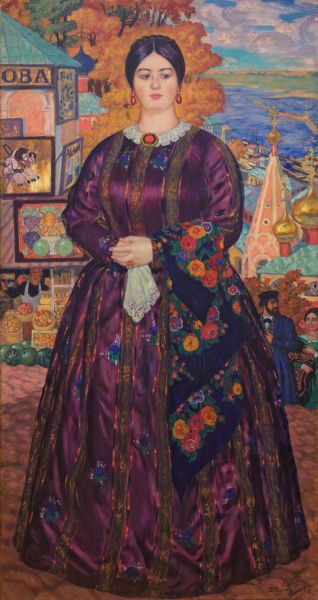|
|
Merchant’s Wife. 1915

Kustodiev Boris,
Oil on canvas
204 x 109
State Russian Museum
Annotation
Boris Kustodiev continued to paint moving and colourful images even after illness had deprived him of the power to move independently. As the artist himself correctly noted, he inhabited a magical kingdom of recollections, daydreams and nostalgic visions.
Kustodiev’s motifs and subjects symbolised a life that had disappeared irrevocably into the past, yet had still lost none of its tart aroma. With their portly figures, ruddy cheeks and flowing movements, his haughty merchant’s wives personified the Russian national ideal of health and beauty.
They were often the heroines of Boris Kustodiev’s half-ironic, halfadmiring picture panels. After the revolution, the artist’s images of merchant’s wives were perceived as a vision of a life that had slipped irrevocably into the past — the comfortable and regulated lifestyle of the merchant class, which had existed in Russia for centuries and had now vanished forever.
Author's Biography
Kustodiev Boris
Kustodiev, Boris Mikhailovich (1818, Astrakhan - 1927, Leningrad)
Painter. Studied under Vasily Savinsky and Ilya Repin at the Higher School of Art, Imperial Academy of Arts (1896-1903). Fellow of the Imperial Academy of Arts in France and Spain (1903-1904). Academician of painting (1909). Founding member of the New Society of Artists (1904) and member of the Union of Russian Artists (1907), World of Art (1910) and the Association of Artists of Revolutionary Russia (1923). Contributed to exhibitions (from 1900). Contributed to the periodical exhibitions of the Moscow Society of Lovers of the Arts (1900-1901), Spring Exhibitions of the Imperial Academy of Arts (1900-1903) and the exhibitions of the New Society of Artists (1904-1908), Union of Russian Artists (1907-1910), World of Art (1910-1924), Association of Artists of Revolutionary Russia (1923, 1925) and the International Exhibitions in Munich (1901, gold medal; 1909) and Malmo (1914, gold medal). Designed for theatres in Moscow and St Petersburg (from 1911).

